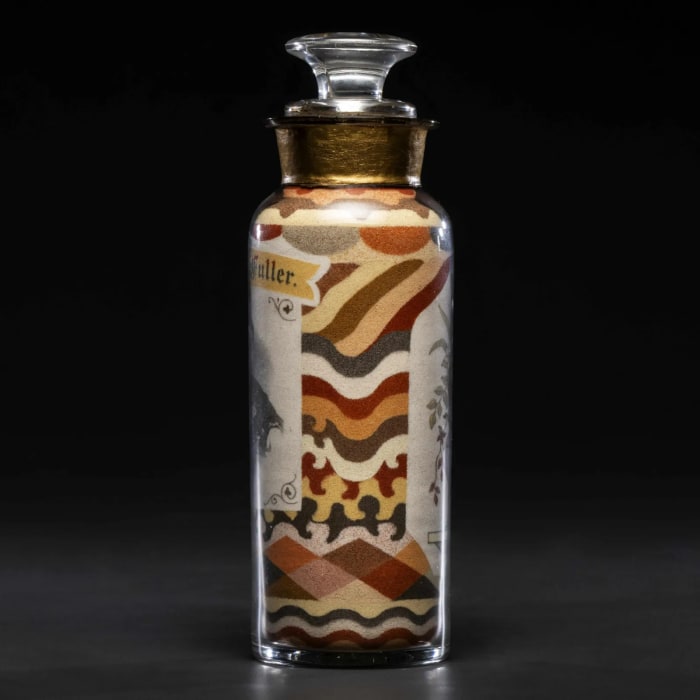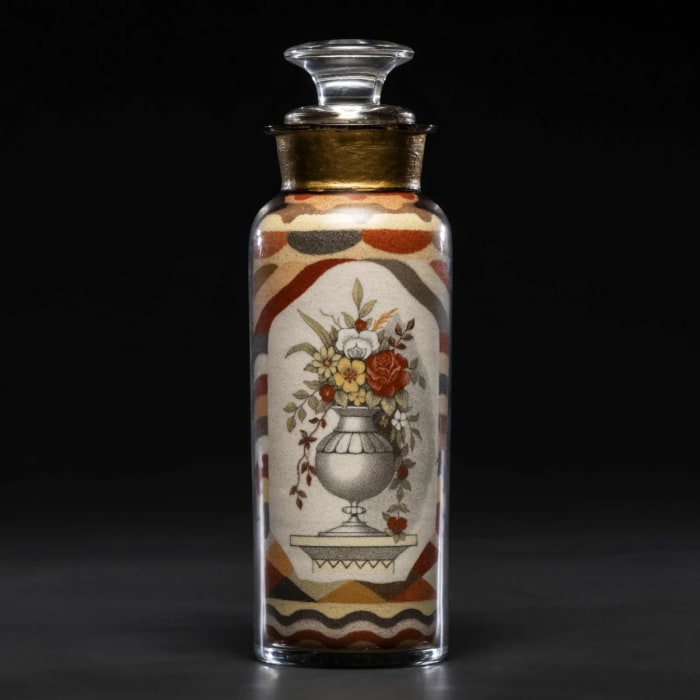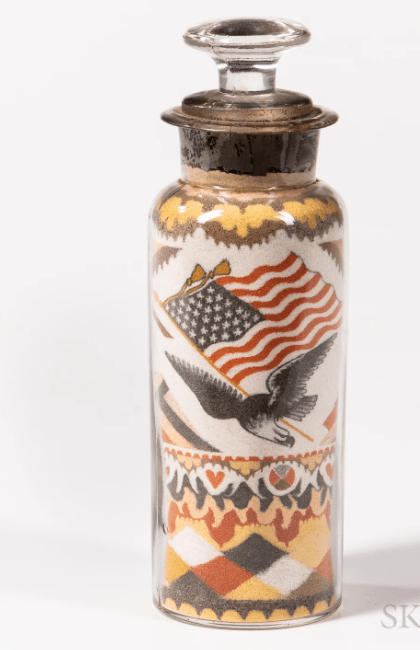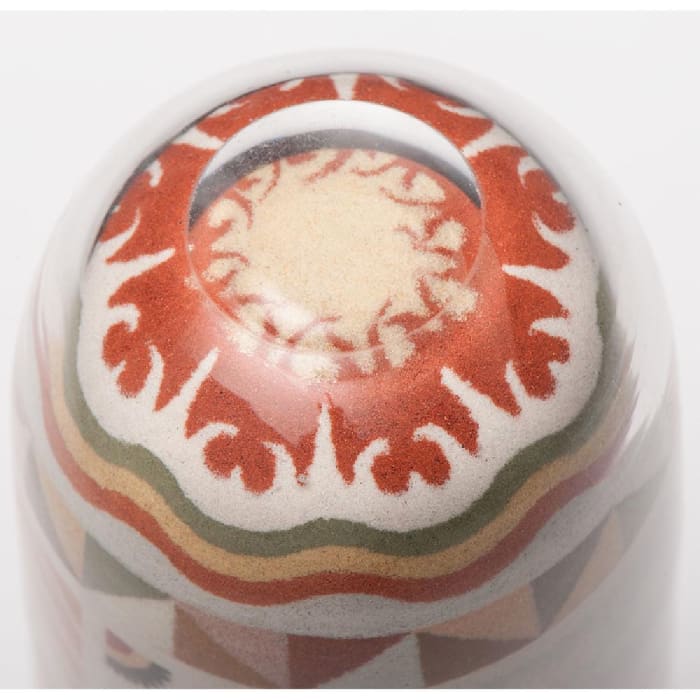In the latter half of the 19th century, there were limited job opportunities for people with disabilities, so when he carved his career path, Andrew Clemens turned to the hobby he enjoyed during his summer vacations from school — sand art.
A self-taught folk artist, Clemens’ delicate craftsmanship of his sand art, contained in small apothecary bottles, is desired by collectors and some examples sell at auction for six figures — one of these bottles just set a new world record at Hindman Auctions in Cincinnati, Ohio, after selling for $956,000.
This result shatters the pre-sale estimate of $100,000-$150,000, and also the previous record set in November 2020, when Skinner sold one of his sand art bottles for $275,000.
Collectors piled on the bidding for the bottle of sand offered by Hindman on September 30, with 64 placed in six minutes, starting with the opening bid of $50,000 to the final price.
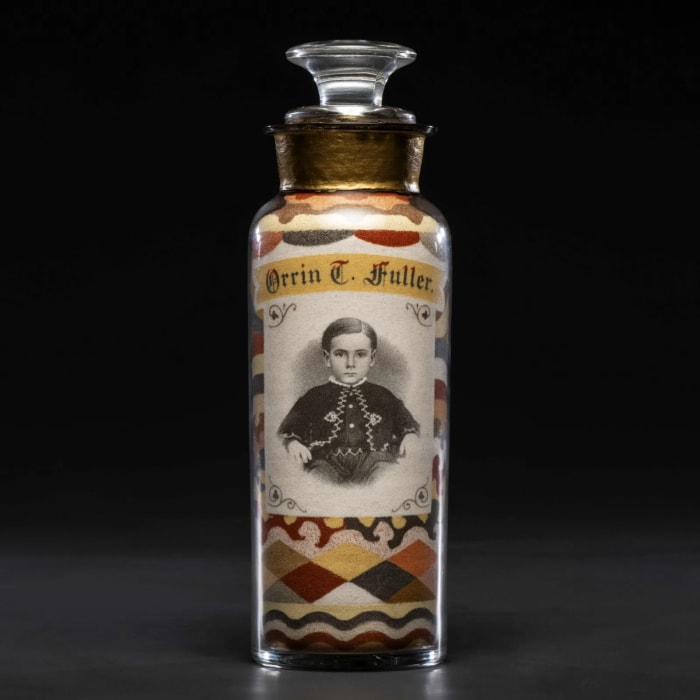
This rare and record-breaking bottle of sand art by Andrew Clemens is the only known example that features a portrait; 8-3/4″ h.
Courtesy of Hindman
According to Hindman, of the more than 100 documented Clemens’ bottles, this example, dating from the late 1880s, is the only known one exhibiting a portrait. An impressive bottle measuring eight and three-quarter inches high, it features an almost photographic depiction of Orrin “O.T.” Fuller of Savanna, Illinois, at around four or five years old. The image has a photographic quality that suggests Clemens used a carte de visite, the type of photograph popular in the 1860s, as the model, said Hindman. Clemens put “O.T. Fuller” in script on the front side and an elaborate floral urn on the opposite; both decorations are flanked by geometric flourishes typical of those he used in his art.
The piece, dubbed “The Boy in the Bottle,” has remained in the Fuller family since it was made, but the reason for its purchase is unknown. Most Clemens’ bottles were commissioned as gifts, which is the most plausible explanation for this example, said Hindman. Though the family has no direct knowledge of why it was made, Fuller’s older sister, Angeline Fuller Fischer, likely commissioned it as a gift for him. Fischer, who was left completely deaf and nearly blind after being stricken with whooping cough when she was 13, rose to national prominence when she began advocating for the rights of deaf women, so it’s likely that she was aware of Clemens, “the deaf-mute” sand artist from Iowa, whose fame had spread up and down the Mississippi River and beyond, said the auction house.
Born in 1857 in Iowa, Clemens contracted encephalitis as a young child and lost his hearing and much of his speech. He eventually attended the Iowa School for the Deaf and during his summer breaks, he visited Pikes Peak State Park along the Mississippi River in his home state.
Near the aptly named Sand Cave in the park, Clemens found and collected grains of sand that were vividly colored from naturally occurring iron and minerals that leached into it. He also collected sand from the sandstone cliffs at Pictured Rocks National Lakeshore in Michigan’s Upper Peninsula. He put labels on the bottom of his bottles indicating where the sand was sourced.
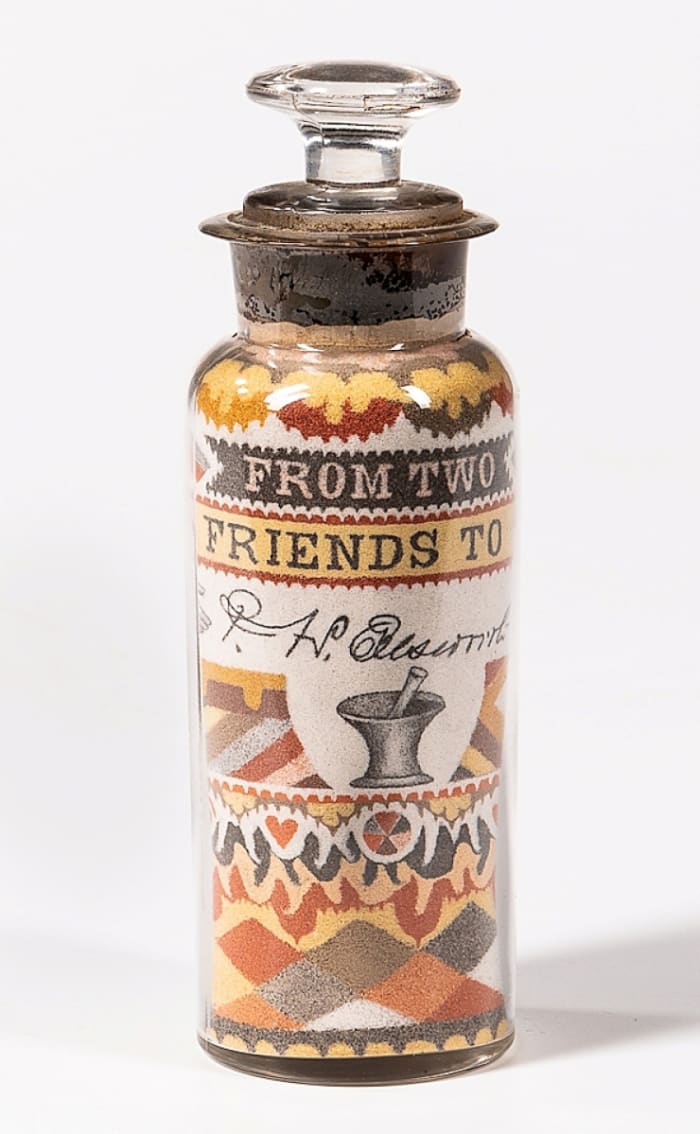
Andrew Clemens’ “From Two Friends” sand art bottle, c. 1885-90, which had set a record at Skinner in 2020, after selling for $275,000. The patriotic-themed bottle, a dedication to Dr. Prosper Harvey Ellsworth, features an eagle, flag, mortar and pestle, and geometric and abstract designs; 7-1/4″ h.
Courtesy of Skinner
Clemens would bring home sand in many different colors including pure white, red, blue, green, yellow and ochre, and sort it into different bottles. He used these to create his sand art without the benefit of glue or artificial coloring and amazingly, he created these mostly upside down, as the bottle’s opening, sealed upon completion, would be at the top.
He used tempered hickory sticks with specially designed tips or fish hooks to deposit and position naturally colored grains of sand inside the bottles. Clemens created elaborate designs grain by grain, using only different colors of sand in much the same way an artist uses paints on a palette. Many have since attempted to duplicate his technique but his works of art remain unmatched.
Clemens started out making simple and attractive geometric designs, and as his skill and talent grew, he began crafting complex pictures including sailing ships, George Washington riding a horse, landscapes and more. His patriotic designs are among his best-loved and most desirable to collectors.
“One jar of this sand, representing the forty odd colors, weighing twenty pounds, we particularly admired as displaying the skill and ingenuity of the young artist who has arranged the various colors in an attractive, artistic and skillful manner,” the North Iowa Times wrote in 1875. “The young artist was just fourteen days engaged upon this one jar.”
Clemens’ meticulously crafted masterpieces were painstakingly time-consuming to make, with some requiring over a year of labor. The most intricate bottles had shading and were three-dimensional. He was most productive from 1880 to 1886.
The State Historical Society of Iowa has a collection of Clemens’ artworks, including this famed bottle from 1888 depicting Washington on horseback. According to the society, Clemens made this as a gift for his mother and it took him around 18 months to complete, working intermittently.
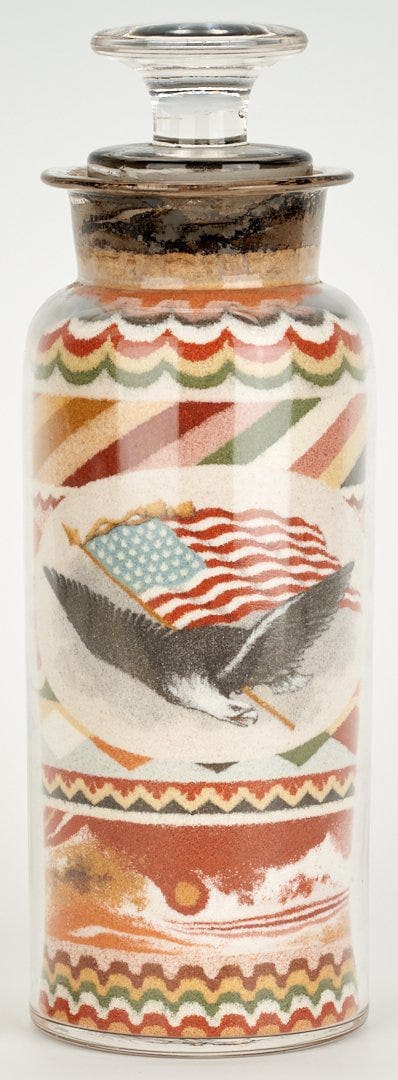
Another patriotic sand art bottle, dated 1889, filled with multicolored, layered sand in decorative stripe, swag and diamond patterns, one side with a vignette of a spread-winged eagle and 36-star American flag, the alternate side with a detailed floral vignette including forget-me-nots, roses and pansies, 6-5/8″ h. This sold at auction for $55,000 against a high estimate of $12,000.
Courtesy of Case Antiques
As Clemens established himself in the community, he started taking commissions for the sand art bottles. Some customers requested their own names written in elaborate script, while others preferred delicate flower scenes. He typically sold them for between $5 and $7.
It’s not known how many sand art pieces Clemens created in his lifetime, but only a small amount have survived. The bottles are fragile and many have been broken over the years — sometimes on purpose. Clemens once worked at the Kohl & Middleton’s Dime Museum in Chicago, constructing simple designs as the public watched. His finished bottles were then dramatically smashed with a hammer to demonstrate that no magic was involved.
Today, the bottles are in private and museum collections throughout the United States, and more than a century after the surviving samples were produced, their worth has increased exponentially when they come to auction. Several other of his bottles have sold at auction this year for between $1,400 to $60,000. Although pre-sale estimates in recent years have typically been between $20,000 and $30,000, the most elaborate pieces soar far above those estimates.
Interest in Clemens’ sand art began trending upward after a bottle sold at a 2015 Eldred’s auction for $72,000. It was from the estate of Tony Award-winning American actress and Kennedy Center honoree, Julie Harris. In 2018, a custom bottle for Mrs. Eliza B. Lewis, featuring a spread-winged American eagle beneath a 36-star flag and a bouquet of flowers, sold for $132,000 at Cowan’s Auctions, which was a record at the time. The hammer price was almost four times the high estimate of $35,000. In that same sale, an inverted sand bottle featuring a nautical scene as well as an eagle and flag made $108,000. In 2019, Cowan’s, which joined with Hindman also in 2019, sold another bottle for $102,000, featuring a patriotic, spread-winged eagle motif.
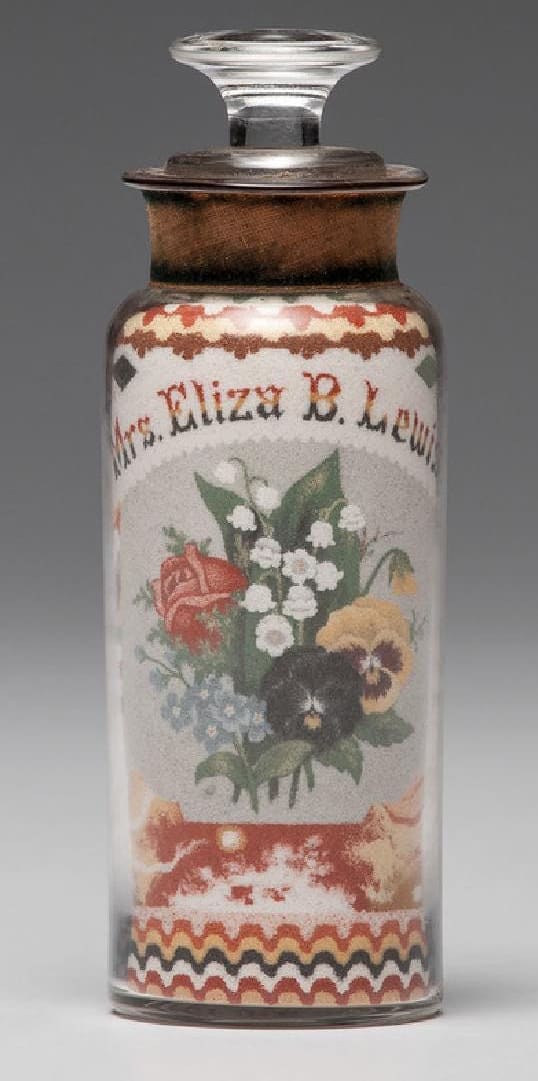
A Clemens’ sand bottle with an American spread-winged eagle underneath a flag of thirty-six stars on one side, the other having a floral bouquet below the name Mrs. Eliza B. Lewis, decorated with layered, colored sands in geometric patterns, 6-3/4″ h; $132,000.
Courtesy of Cowan’s Auctions
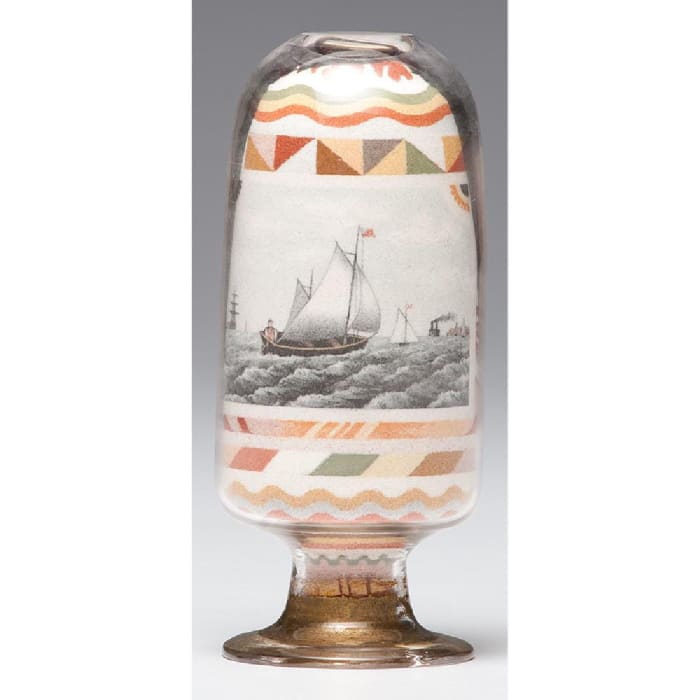
This inverted sand bottle with a nautical and patriotic theme, 6-1/4″ h, realized $108,000 at Cowan’s in 2018.
Courtesy of Cowan’s Auctions
Although Clemens did not live long enough to enjoy fame, he did begin receiving recognition shortly before his death in 1894 at the age of 37.
“Our people do not properly appreciate this art. The master doesn’t seem to know its worth nor does he seem to realize his exalted position among the inventors of the world,” a newspaper editor wrote in 1888.
Clemens continues to find fans today and his work is appreciated for its mastery and artistry, and the remarkable patience and precision it took to craft.



